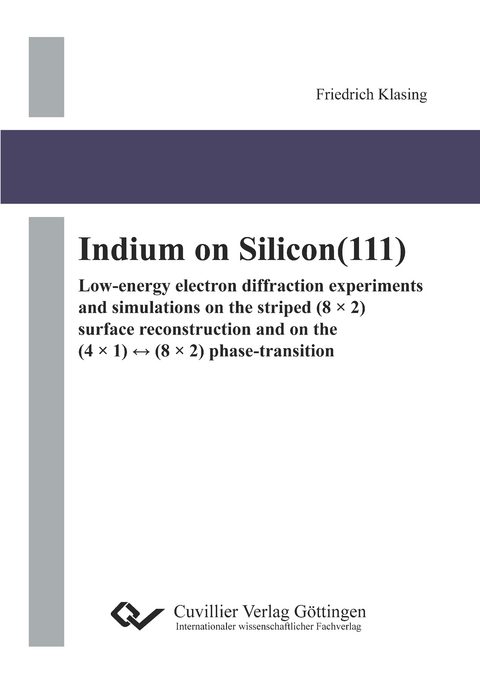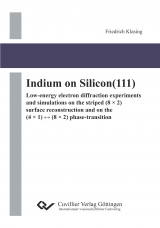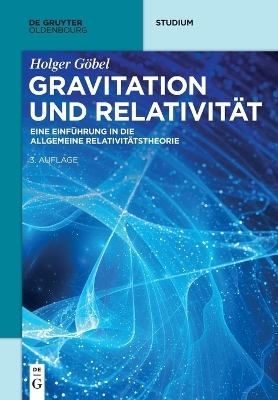Indium on Silicon(111)
Low-energy electron diffraction experiments and simulations on the striped (8 × 2) surface reconstruction and on the (4 × 1) ↔ (8 × 2) phase-transition
Seiten
2014
|
1., Aufl.
Cuvillier Verlag
978-3-95404-813-7 (ISBN)
Cuvillier Verlag
978-3-95404-813-7 (ISBN)
- Keine Verlagsinformationen verfügbar
- Artikel merken
Indium on silicon is a system showing a vast variety of reconstructions depending on preparation and substrate morphology. The (4×1) reconstruction, a self assembled quasi one dimensional chain of indium atoms, can be found among them. It exhibits a reversible phase transition at temperatures of 130 K into a (8 × 2) reconstruction.
The nature of the phase transition as well as its driving force have been discussed for more than a decade now. Effects like a Peierls transition, simple lattice distortion and even Jahn-Teller distortions are being considered as the cause of the transition. The question of whether it is of first- or second-order is answered by showing the existence of a robust hysteresis loop of the order parameter, i.e. it is a transition of first-order. The width of the hysteresis of the (4×1)?(8×2) phase-transition is measured by means of high resolution low electron energy diffraction and is determined to be 8.6 K. Furthermore the Si(111)(8×2)-In reconstruction is a system showing a weak correlation between the neighbouring chains which is easily disturbed by adsorbates. The influence of three different adsorbates, namely argon, molecular oxygen and water on the transition characteristics is studied. All of them interact with the surface in a different way. Argon has only a small influence on the transition characteristics and is found to mainly influence the measurement as a diffusive scattering point defect. The expected raise in transition temperature could not be observed. Like argon, the exposure to molecular oxygen seems to reduce the influence of the reconstructions age, i.e. permanent exposure to residual gases, on the transition characteristics. The influence of water adsorption is found to be bigger and contrary to the influence of oxygen and argon. Exposure to small amounts of water heavily disturbs the correlation between rows and growing of (8×2) domains. The reconstruction rapidly ages.
Wall et al. excited an extremely undercooled surface state by means of fs-laser excitation as well as to characterize its decay by means of time resolved reflection high electron diffraction. An atomistic model, i.e. a falling row of dominoes, has subsequently been developed. An interesting phenomenon was observed though the rapid ageing of the reconstruction helped explaining it. Necessary expansions of this model are tested by simulating the decay of the high-temperature phase.
The nature of the phase transition as well as its driving force have been discussed for more than a decade now. Effects like a Peierls transition, simple lattice distortion and even Jahn-Teller distortions are being considered as the cause of the transition. The question of whether it is of first- or second-order is answered by showing the existence of a robust hysteresis loop of the order parameter, i.e. it is a transition of first-order. The width of the hysteresis of the (4×1)?(8×2) phase-transition is measured by means of high resolution low electron energy diffraction and is determined to be 8.6 K. Furthermore the Si(111)(8×2)-In reconstruction is a system showing a weak correlation between the neighbouring chains which is easily disturbed by adsorbates. The influence of three different adsorbates, namely argon, molecular oxygen and water on the transition characteristics is studied. All of them interact with the surface in a different way. Argon has only a small influence on the transition characteristics and is found to mainly influence the measurement as a diffusive scattering point defect. The expected raise in transition temperature could not be observed. Like argon, the exposure to molecular oxygen seems to reduce the influence of the reconstructions age, i.e. permanent exposure to residual gases, on the transition characteristics. The influence of water adsorption is found to be bigger and contrary to the influence of oxygen and argon. Exposure to small amounts of water heavily disturbs the correlation between rows and growing of (8×2) domains. The reconstruction rapidly ages.
Wall et al. excited an extremely undercooled surface state by means of fs-laser excitation as well as to characterize its decay by means of time resolved reflection high electron diffraction. An atomistic model, i.e. a falling row of dominoes, has subsequently been developed. An interesting phenomenon was observed though the rapid ageing of the reconstruction helped explaining it. Necessary expansions of this model are tested by simulating the decay of the high-temperature phase.
| Erscheint lt. Verlag | 1.10.2014 |
|---|---|
| Sprache | englisch |
| Einbandart | Paperback |
| Themenwelt | Naturwissenschaften ► Physik / Astronomie |
| Schlagworte | diffraction • Silicon • Silizium |
| ISBN-10 | 3-95404-813-2 / 3954048132 |
| ISBN-13 | 978-3-95404-813-7 / 9783954048137 |
| Zustand | Neuware |
| Haben Sie eine Frage zum Produkt? |
Mehr entdecken
aus dem Bereich
aus dem Bereich
Eine Einführung in die Allgemeine Relativitätstheorie
Buch | Softcover (2023)
De Gruyter Oldenbourg (Verlag)
59,95 €
Problem Solving with Python
Buch | Softcover (2024)
Wiley-VCH (Verlag)
109,00 €




